


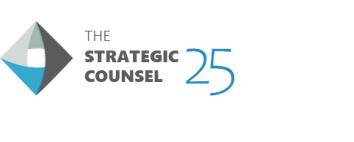
Target audience
| LOCATION | GROUP | LANGUAGE | DATE | TIME (EST) | GROUP COMPOSITION | NUMBER OF PARTICIPANTS |
|---|---|---|---|---|---|---|
| Newfoundland and Labrador | 1 | English | Jan. 6 | 4:30-6:30 pm | Former CERB Recipients | 7 |
| Quebec City | 2 | French | Jan. 7 | 6:00-8:00 pm | 6:00-8:00 pm Former CERB Recipients | 6 |
| Ontario – Major Centres | 3 | English | Jan. 12 | 6:00-8:00 pm | Vaccine Hesitant | 7 |
| Manitoba/ Saskatchewan | 4 | English | Jan. 12 | 8:00-10:00 pm | Indigenous | 7 |
| Alberta – Mid-size and Major Centres | 5 | English | Jan. 13 | 8:00-10:00 pm | Racialized Canadians | 8 |
| Greater Montreal Area (GMA) | 6 | French | Jan. 14 | 6:00-8:00 pm | Vaccine Hesitant | 6 |
| Manitoba, Ontario, New Brunswick | 7 | French | Jan. 18 | 6:00-8:00 pm | Francophones – General Population | 8 |
| Vancouver Island | 8 | English | Jan. 20 | 9:00-11:00 pm | Seniors (aged 55+) | 7 |
| New Brunswick | 9 | English | Jan. 21 | 6:00-8:00 pm | General Population | 7 |
| Greater Toronto Area (GTA) | 10 | English | Jan. 25 | 6:00-8:00 pm | Parents – Children in daycare and/or considering daycare | 7 |
| Saskatchewan – Mid-size and Major Centres | 11 | English | Jan. 26 | 8:00-10:00 pm | General Population | 8 |
| Interior B.C. | 12 | English | Jan. 28 | 9:00-11:00 pm | General Population | 8 |
| Total number of participants | 86 | |||||
| Major Centres Ontario Vaccine Hesitant | Manitoba and Saskatchewan Indigenous Peoples | Mid-size and Major Centres Alberta Racialized Canadians | GMA Vaccine Hesitant | Vancouver Island Seniors |
|---|
| Version A | X | X | X | ||
|---|---|---|---|---|---|
| Version B | X | X | X | X | |
| Version C | X | ||||
| Banner Ad | X |
| Version A | X | X | X | ||
|---|---|---|---|---|---|
| Version B | X | X | X | X | |
| Version C | X | ||||
| Banner Ad | X |
| Version A | X | X | X | ||
|---|---|---|---|---|---|
| Version B | X | X | X | X | |
| Version C | X | ||||
| Banner Ad | X |

The above figure consists of six frames. The first frame is split vertically down the middle, on the left-hand side there is a dark grey background with large, white text reading ‘A dose of facts’ with the word ‘facts’ underlined. Below, in slightly smaller font, the text reads ‘COVID-19 vaccine’ with an icon of a circle containing a vaccine syringe and vial to the left of the text. On the right-hand side of the frame, there is an image of a man with a young boy on his back, both of whom are smiling. The second frame is, again, dark grey and white font reads ‘The COVID-19 vaccines can help protect you’ with ‘protect you’ being in yellow font. The third frame is the same dark grey with white text reading ‘against serious illness, long-term health effects and even death.’ The fourth frame is the same image of the father and young boy as was seen in the first frame. The fifth frame is back to the dark grey background that reads ‘Get informed. Get vaccine-ready.’ In white, bold font with an icon of a circle containing a vaccine syringe and vial to the left of the text. At the bottom of the frame, yellow text presents the URL ‘Canada.ca/coronavirus.’ The final frame ends on a white background with the Canada Wordmark in the middle.
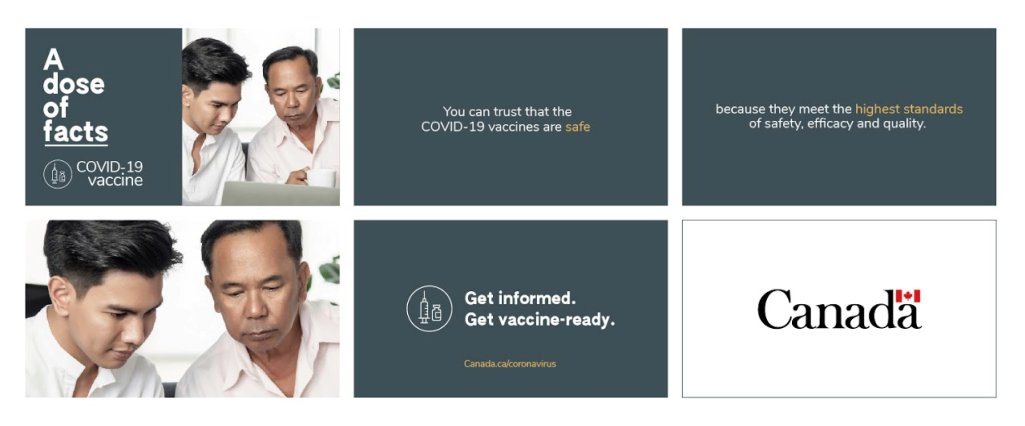
The above figure consists of six frames. The first frame is split vertically down the middle, on the left-hand side there is a dark grey background with large, white text reading ‘A dose of facts’ with the word ‘facts’ underlined. Below, in slightly smaller font, the text reads ‘COVID-19 vaccine’ with an icon of a circle containing a vaccine syringe and vial to the left of the text. On the right-hand side of the frame, there is an image of a man and a younger man both reading a document. The second frame is, again, dark grey and white font reads ‘You can trust that the COVID-19 vaccines are safe’ with ‘safe’ being in yellow font. The third frame is the same dark grey with white text reading ‘because they meet the highest standards of safety, efficacy and quality’ with ‘highest standards’ in yellow font. The fourth frame is the same image of the man and a younger man both reading a document as was seen in the first frame. The fifth frame is back to the dark grey background that reads ‘Get informed. Get vaccine-ready.’ In white, bold font with an icon of a circle containing a vaccine syringe and vial to the left of the text. At the bottom of the frame, yellow text presents the URL ‘Canada.ca/coronavirus.’ The final frame ends on a white background with the Canada Wordmark in the middle.
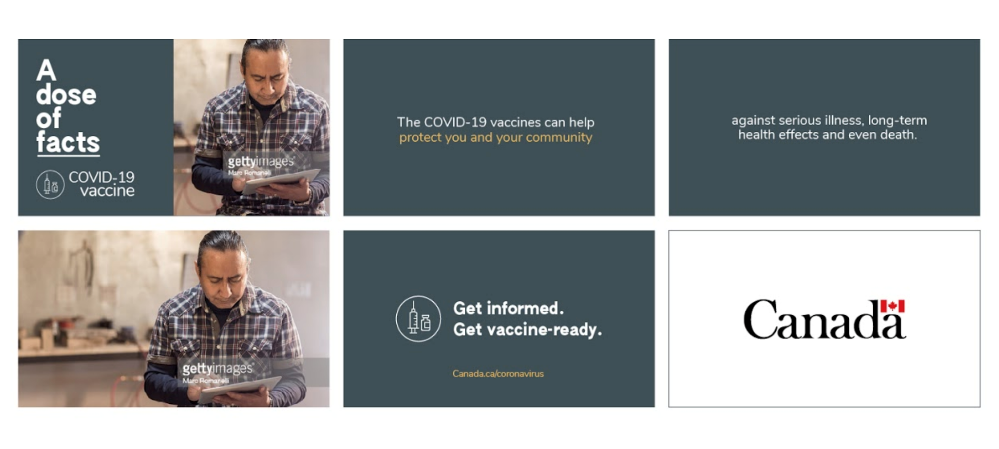
The above figure consists of six frames. The first frame is split vertically down the middle, on the left-hand side there is a dark grey background with large, white text reading ‘A dose of facts’ with the word ‘facts’ underlined. Below, in slightly smaller font, the text reads ‘COVID-19 vaccine’ with an icon of a circle containing a vaccine syringe and vial to the left of the text. On the right-hand side of the frame, there is an image of a man in a plaid shirt who is drawing. The second frame is, again, dark grey and white font reads ‘The COVID-19 vaccines can help protect you and your community’ with ‘protect you and your community’ being in yellow font. The third frame is the same dark grey with white text reading ‘against serious illness, long-term health effects and even death.’ The fourth frame is the same image of the man in a plaid shirt who is drawing as was seen in the first frame. The fifth frame is back to the dark grey background that reads ‘Get informed. Get vaccine-ready.’ In white, bold font with an icon of a circle containing a vaccine syringe and vial to the left of the text. At the bottom of the frame, yellow text presents the URL ‘Canada.ca/coronavirus.’ The final frame ends on a white background with the Canada Wordmark in the middle.
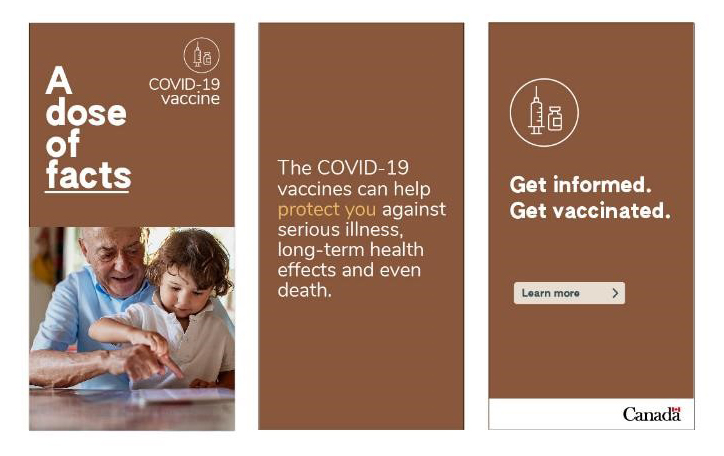
The above figure consists of three frames. The first frame is split horizontally across the middle, the top half has a brown background with large, white text reading ‘A dose of facts’ with the word ‘facts’ underlined. To the right, in slightly smaller font, the text reads ‘COVID-19 vaccine’ with an icon of a circle containing a vaccine syringe and vial above the text. On the bottom half of the image, there is an image of an elderly man with a child on his lap and they are looking down and pointing at a document. The second frame is, again, brown and white font reads ‘The COVID-19 vaccines can help protect you against serious illness, long-term health effects and even death’ with ‘protect you’ being in yellow font. The third frame is the same brown with white text reading ‘Get informed. Get vaccinated.’ with an icon of a circle containing a vaccine syringe and vial above the text. Below the text, there is a white, callout box that reads ‘Learn more’ with an arrow in green font. At the bottom of the frame, there is a white strip that has the Canada Wordmark on the bottom right.
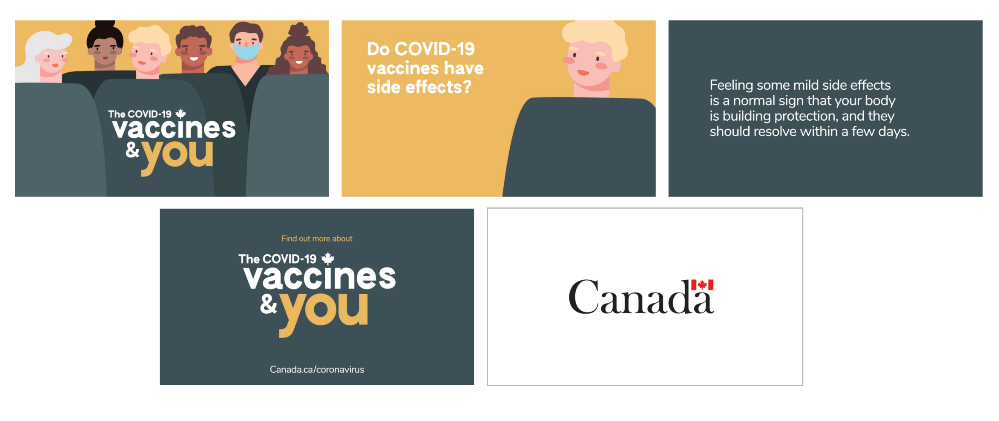
The above figure consists of five frames. The first frame has a yellow background was six animated figures shown (in order from left to right, there is a woman with light skin and white hair, a woman with darker skin and black hair in a bun, a light skin male with short, blond hair, a male with darker skin and short, brown hair, a male with light skin, short brown hair and a blue face mask, and a woman with darker skin and dark brown curly hair), all wearing dark green shirts. There is also text in the middle of the frame. Smaller white font reads ‘the COVID-19 vaccine’ with a maple leaf to the right. Underneath, in larger white font reads ‘vaccines & you’ with the word ‘you’ in yellow font. The second frame has the same yellow background with white font on the left-hand side reading ‘Do COVID-19 vaccines have side effects?’ to the right-hand side, the light skin and short blond hair male animated figure is looking in the direction of the text. The next slide has a dark grey background with white text reading ‘Feeling some mild side effects is a normal sign that your body is building protection, and they should resolve within a few days.’ The next slide has a similar dark grey background, at the top, there is small yellow font reading ‘Find out more about’ with ‘The COVID-19 vaccines & you’ below. To the right of the word ‘COVID-19’ there is a maple leaf and the word ‘you’ is in yellow. At the bottom of the frame, there is white font reading ‘Canada.ca/coronavirus.’ The final frame has a white background with the Government of Canada Wordmark in the middle.
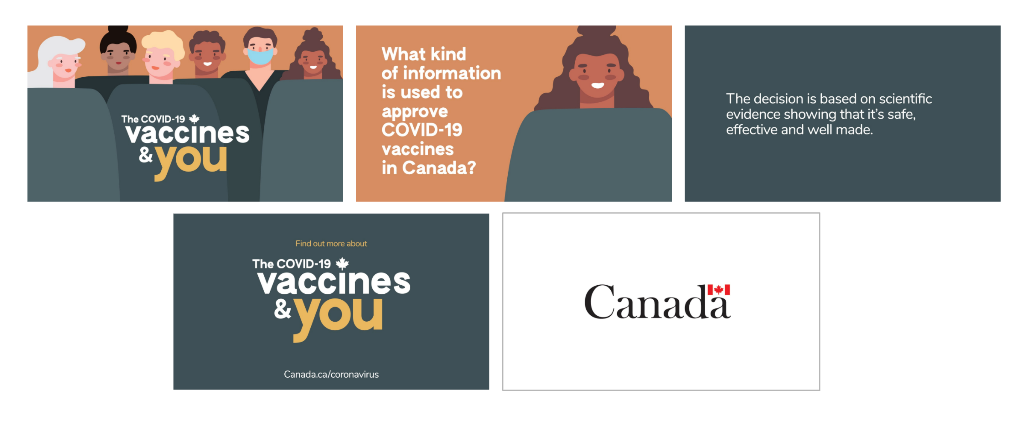
The above figure consists of five frames. The first frame has an orange background was six animated figures shown (in order from left to right, there is a woman with light skin and white hair, a woman with darker skin and black hair in a bun, a light skin male with short, blond hair, a male with darker skin and short, brown hair, a male with light skin, short brown hair and a blue face mask, and a woman with darker skin and dark brown curly hair), all wearing dark green shirts. There is also text in the middle of the frame. Smaller white font reads ‘the COVID-19 vaccine’ with a maple leaf to the right. Underneath, in larger white font reads ‘vaccines & you’ with the word ‘you’ in yellow font. The second frame has the same orange background with white font on the left-hand side reading ‘What kind of information is used to approve COVID-19 vaccines in Canada?’ to the right-hand side, the darker skinned female with brown curly hair animated figure is smiling and looking straight out. The next slide has a dark grey background with white text reading ‘The decision is based on scientific evidence show that it’s safe, effective and well made.’ The next slide has a similar dark grey background, at the top, there is small yellow font reading ‘Find out more about’ with ‘The COVID-19 vaccines & you’ below. To the right of the word ‘COVID-19’ there is a maple leaf and the word ‘you’ is in yellow. At the bottom of the frame, there is white font reading ‘Canada.ca/coronavirus.’ The final frame has a white background with the Government of Canada Wordmark in the middle.
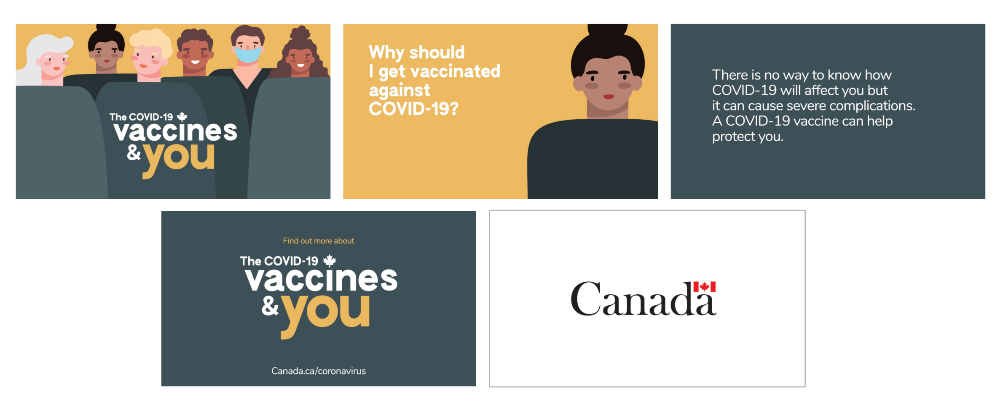
The above figure consists of five frames. The first frame has a yellow background was six animated figures shown (in order from left to right, there is a woman with light skin and white hair, a woman with darker skin and black hair in a bun, a light skin male with short, blond hair, a male with darker skin and short, brown hair, a male with light skin, short brown hair and a blue face mask, and a woman with darker skin and dark brown curly hair), all wearing dark green shirts. There is also text in the middle of the frame. Smaller white font reads ‘the COVID-19 vaccine’ with a maple leaf to the right. Underneath, in larger white font reads ‘vaccines & you’ with the word ‘you’ in yellow font. The second frame has the same yellow background with white font on the left-hand side reading ‘Why should I get vaccinated against COVID-19?’ to the right-hand side, the darker skin female with black hair in a bun animated figure is looking straight out. The next slide has a dark grey background with white text reading ‘There is no way to know how COVID-19 will affect you but it can cause severe complications. A COVID-19 vaccine can help protect you.’ The next slide has a similar dark grey background, at the top, there is small yellow font reading ‘Find out more about’ with ‘The COVID-19 vaccines & you’ below. To the right of the word ‘COVID-19’ there is a maple leaf and the word ‘you’ is in yellow. At the bottom of the frame, there is white font reading ‘Canada.ca/coronavirus.’ The final frame has a white background with the Government of Canada Wordmark in the middle.
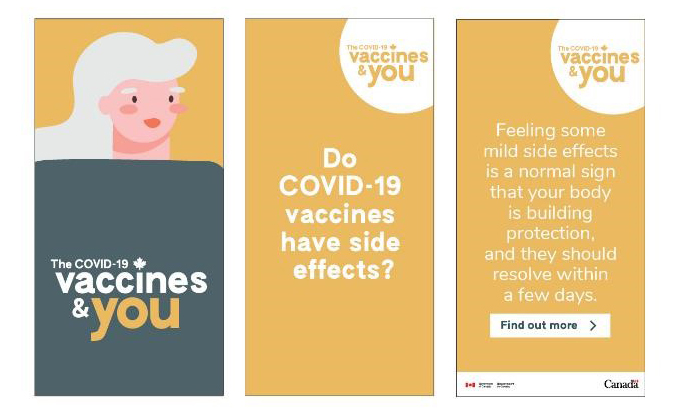
The above figure consists of three frames. The first frame has a yellow background with a female with light skin and white hair animated figure who is wearing a green shirt. Overlaid on the shirt there is smaller white font reads ‘the COVID-19 vaccine’ with a maple leaf to the right. Underneath, in larger white font reads ‘vaccines & you’ with the word ‘you’ in yellow font. The second frame has the same yellow background with white text in the middle of the frame reading ‘Do COVID-19 vaccines have side effects?’ In the top right of the frame, there is a white circle with yellow font, where smaller font reads ‘the COVID-19 vaccine’ with a maple leaf to the right. Underneath, in a larger font reads ‘vaccines & you.’ The third frame has the same yellow background with white text reading ’Feeling some mild side effects is a normal sign that your body is building protection, and they should resolve within a few days.’ Below, there is a white callout box with green font inside reading ‘learn more’ with an arrow. In the top right of the frame, there is a white circle with yellow font, where smaller font reads ‘the COVID-19 vaccine’ with a maple leaf to the right. Underneath, in a larger font reads ‘vaccines & you.’ At the bottom of the slide, there is a white bar across the bottom that features the Government of Canada wordmark on the right and a governmental department logo on the left.

The above figure consists of five frames. The first frame has a dark grey background with white text reading ‘Ask a COVID-19 vaccine expert’ with the words ‘vaccine expert’ in yellow font. The second frame depicts a young, smiling man against a light background, with the words ‘How do the COVID-19 vaccines work?’ to the right in dark green font. The third frame depicts Dr. Howard Njoo, Deputy Chief Public Health Officer (with his name and title overlaid in text on the bottom right of the frame) sitting at his desk. Below, the text reads ‘Dr. Howard Njoo (to camera) They word with your immune system so your body will be ready to fight the virus if you are exposed.’ The fourth frame depicts the same young man previously shown, although he is against a darker grey background now, and the text to the right reads ‘Make an informed decision about vaccination’ in white font. Below this text, smaller yellow test reads ‘Canada.ca/coronavirus.’ The final frame has a white background with the Canada Workmark in the middle.

The above figure consists of five frames. The first frame has a dark grey background with white text reading ‘Ask a COVID-19 vaccine expert’ with the words ‘vaccine expert’ in yellow font. The second frame depicts a young, smiling woman against a light background, with the words ‘How were the COVID-19 vaccines developed so quickly?’ to the right in dark green font. The third frame depicts Dr. Caroline Quach, Medical Lead, Infection Prevention and Control, CHU Ste-Justine (with her name and title overlaid in text on the bottom right of the frame) smiling towards the camera. Below, the text reads ‘Dr. Caroline Quach (to camera) The COVID-19 vaccines were developed quickly thanks to advances in science, international collaboration and increased funding.’ The fourth frame depicts the same young woman previously shown, although she is closer up and is against a darker grey background now, and the text to the right reads ‘Make an informed decision about vaccination’ in white font. Below this text, smaller yellow test reads ‘Canada.ca/coronavirus.’ The final frame has a white background with the Canada Workmark in the middle.

The above figure consists of five frames. The first frame has a dark grey background with white text reading ‘Ask a COVID-19 vaccine expert’ with the words ‘vaccine expert’ in yellow font. The second frame depicts an older woman against a light background, with the words ‘Why should I get vaccinated against COVID-19?’ to the right in dark green font. The third frame depicts Dr. Evan Adams, Deputy Chief Medical Officer, Indigenous Services Canada (with his name and title overlaid in text on the bottom right of the frame). Below, the text reads ‘Dr. Evan Adams (to camera) The COVID-19 vaccines can help protect you and your community against serious illness, long-term health effects and even death.’ The fourth frame depicts the same older woman previously shown, although she is against a darker grey background now, and the text to the right reads ‘Make an informed decision about vaccination’ in white font. Below this text, smaller yellow test reads ‘Canada.ca/coronavirus.’ The final frame has a white background with the Canada Workmark in the middle.

The above figure consists of three frames. The first frame has a dark grey background with white text reading ‘Ask a COVID-19 vaccine expert’ with the words ‘vaccine expert’ in yellow font. Directly below the text, there is an image of Dr. Caroline Quach, Medical Lead, Infection Prevention and Control, CHU Ste-Justine (with his name and title overlaid in text on the bottom right of the frame). The second frame had a white background with green text reading ‘How were the COVID-19 vaccines developed so quickly?’ The third frame had a dark grey background with yellow text reading ‘The COVID-19 vaccines were developed quickly thanks to advances in science, international collaboration and increased funding.’ Below, there is a white callout box with green text reading ‘learn more’ and an arrow. Below this box, there is the same image of Dr. Caroline Quach and her title of Medical Lead, Infection Prevention and Control, CHU Ste-Justine in white text. At the bottom of the frame, there is a white bar across the bottom that features the Government of Canada wordmark on the right.

In the above image, the word ‘Canada’ is written in black font over a white background. Over the final ‘a’ there is a coloured, red and white, Canadian flag.
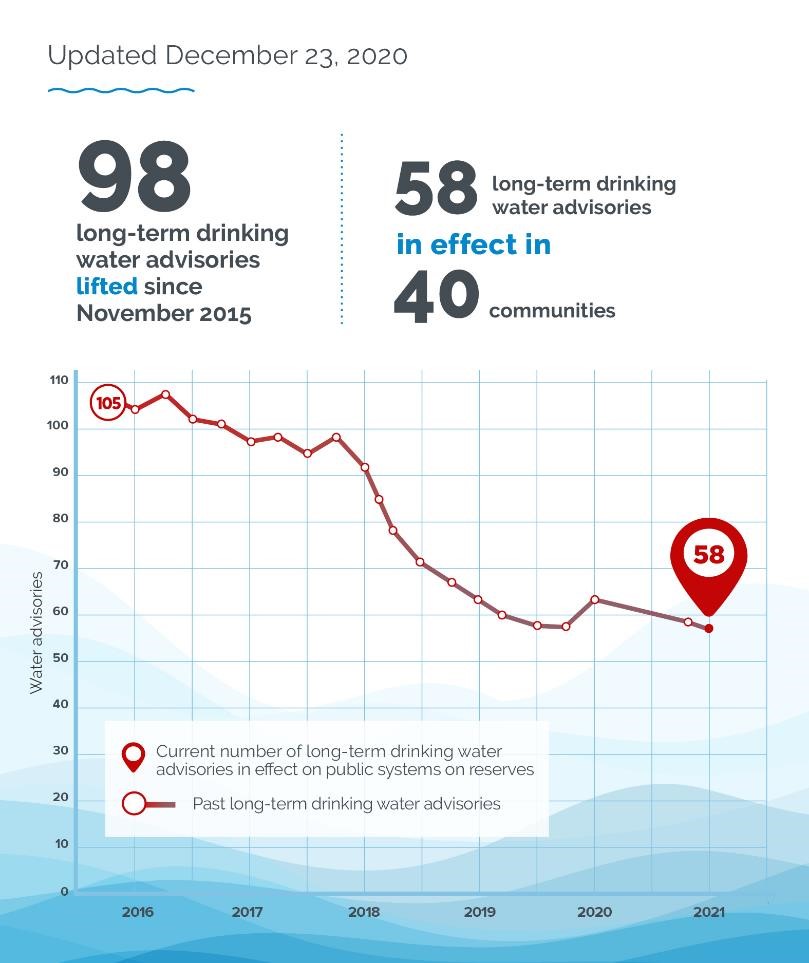
This infographic features a white background with a graphic of blue waves across the bottom third of the page. On the top left, the version date “Updated December 23, 2020” in written grey font underlined by a dark blue waved line. In the middle of the infographic to the left, text reads, “98 long-term drinking water advisories lifted since November 2015” in grey font, with the number “98” in much larger font than the other font, and the word “lifted’” in blue font. In the middle of the infographic to the right, text reads “58 long-term drinking water advisories in effect in 40 communities” where the numbers are in larger font, and the words “in effect in” is written in blue text. At the bottom of the infographic, there is a large chart, along the vertical axis there is water advisories (ranging from 0 to 110), and the horizontal axis is years (ranging from 2016 to 2021). In the graph, a red line tracks downwards, from left to right. The top left of the graph line is in the number 105 in a circle. The bottom right of the graph had the number 58 in a pinpoint icon. In the bottom left hand side of the graph, a legend depicts that the red pinpoint icon is “current number of long-term drinking water advisories in effect on public systems on reserves. Below, the legend depicts that each point on the graph line is “past long-term drinking water advisories.”
| GROUP | DATE | TIME (EST) | TIME (LOCAL) | LOCATION | COMPOSITION | MODER-ATOR |
|---|---|---|---|---|---|---|
| 1 | Wed., Jan. 6 | 4:30-6:30 | 6:00-8:00 (NST) 5:30-7:30 (AST) | Newfoundland and Labrador | Former CERB Recipients | DN |
| 3 | Mon., Jan. 11 | 6:00-8:00 | 6:00-8:00 (EST) | Major Centres - Ontario | Vaccine hesitant | DN |
| 4 | Tues., Jan. 12 | 8:00-10:00 | 7:00-9:00 (CST) | Manitoba/Saskatchewan | Indigenous people | DN |
| 5 | Wed., Jan. 13 | 8:00-10:00 | 6:00-8:00 (MST) | Mid-size and Major Centres – Alberta | Racialized Canadians | TBW |
| 8 | Wed., Jan 20 | 9:00-11:00 | 6:00-8:00 (PST) | Vancouver Island | Seniors | TBW |
| 9 | Thurs., Jan. 21 | 6:00-8:00 | 7:00-9:00 (AST) | New Brunswick | General population | DN |
| 10 | Mon., Jan. 25 | 6:00-8:00 | 6:00-8:00 (EST) | GTA | Parents with children in daycare and/or considering daycare within next 12 months | DN |
| 11 | Tues., Jan. 26 | 8:00-10:00 | 7:00-9:00 (CST) | Mid-size and Larger Centres – Saskatchewan | General population | DN |
| 12 | Thurs., Jan. 28 | 9:00-11:00 | 6:00-8:00 (PST) | Interior B.C. | General population | TBW |
| LOCATION | CITIES | |
|---|---|---|
| Newfoundland/ Labrador | Cities could include (but are not limited to): St. John’s, Conception Bay South, Mount Pearl, Paradise, Corner Brook, Grand Falls-Windsor, Gander, Portugal Cove-St. Phillip`s, Happy Valley-Goose Bay, Torbay, Labrador City, Stephenville, Clarenville, Bay Roberts, and Marystown. MAX OF 3 PARTICIPANTS FROM ST. JOHN’S. ENSURE A GOOD MIX OF CITIES ACROSS THE REGION INCLUDING THOSE RESIDING IN LARGER AND SMALLER COMMUNITIES. |
CONTINUE - GROUP 1 |
| Major Centres - Ontario | Cities include: Toronto, Ottawa and Hamilton. PARTICIPANTS SHOULD RESIDE IN THE ABOVE-NOTED CENTERS PROPER. |
CONTINUE - GROUP 3 |
| Manitoba/Saskatchewan | Cities could include (but are not limited to):
Manitoba: Winnipeg, Brandon, Steinbach, Thompson, Portage la Prairie, Winkler, Selkirk, Morden, Dauphin, The Pas, Flin Flon.
Saskatchewan: Saskatoon, Regina, Prince Alberta, Moose Jaw, Swift Current, Yorkton, North Battleford, Lloydminster, Estevan, Warman, Weyburn, Martensville, Melfort, Humboldt, Meadow Lake.
ENSURE 4 PARTICIPANTS FROM EACH PROVINCE. MAX 2 PARTICIPANTS FROM MAJOR CITIES IN EACH PROVINCE. MAX 2 FROM WINNIPEG AND BRANDON. MAX 2 FROM OR SASKATOON AND REGINA. ENSURE A GOOD MIX OF CITIES ACROSS THE REGION. INCLUDE THOSE RESIDING IN LARGER AND SMALLER COMMUNITIES. |
CONTINUE - GROUP 4 |
| Mid-size and Major Centres Alberta | Cities include: Calgary, Edmonton, Red Deer, Lethbridge, Fort McMurray, St. Albert, Medicine Hat, Grand Prairie, Airdrie. MAX 2 PARTICIPANTS FROM EACH MAJOR CITY – CALGARY AND EDMONTON. ENSURE A GOOD MIX OF CITIES ACROSS THE REGION. |
CONTINUE GROUP 5 |
| Vancouver Island | Cities could include (but are not limited to): Victoria, Nanaimo, Courtney/Comox, Duncan/Cowichan, Campbell River, Parksville/Qualicum Beach, Port Alberni, Sidney, Lady Smith, Sooke.
MAX 3 PARTICIPANTS FROM VICTORIA. ENSURE A GOOD MIX OF CITIES ACROSS THE REGION. INCLUDE THOSE RESIDING IN LARGER AND SMALLER COMMUNITIES. |
CONTINUE - GROUP 8 |
| New Brunswick | Cities could include (but are not limited to): Moncton, Saint John, Fredericton, Dieppe, Miramichi, Edmundston, Bathurst, Campbellton. ENSURE A GOOD MIX OF CITIES ACROSS THE REGION. INCLUDE THOSE RESIDING IN LARGER AND SMALLER COMMUNITIES. |
CONTINUE - GROUP 9 |
| GTA | Cities could include (but are not limited to): City of Toronto, Durham (Ajax, Clarington, Brock, Oshawa, Pickering, Whitby), Halton (Burlington, Halton Hills, Oakville, Milton), Peel (Brampton, Caledon, Mississauga), York (Markham, Vaughan, Richmond Hill, Newmarket, Aurora), Dufferin County (Mono, Orangeville) and Simcoe County. ENSURE A GOOD MIX ACROSS THE GTA. NO MORE THAN TWO IN CITY OF TORONTO, OR PER REGION/COUNTY. INCLUDE THOSE RESIDING IN LARGER AND SMALLER COMMUNITIES. |
CONTINUE - GROUP 10 |
| Mid-size and Larger Centres Saskatchewan | Cities include: Saskatoon, Regina, Prince Albert, Moose Jaw, Swift Current, Yorkton.
MAX 2 PARTICIPANTS FROM EACH MAJOR CITY – SASKATOON AND REGINA. ENSURE A GOOD MIX OF CITIES ACROSS THE REGION. |
CONTINUE - GROUP 11 |
| Interior B.C | Cities could include (but are not limited to): Kamloops, Vernon, Kelowna, Penticton, Peachland Nelson, Cranbrook, Golden, Revelstoke, Prince George, Williams Lake, Fort St. John.
ENSURE A GOOD MIX OF CITIES ACROSS THE REGION. INCLUDE THOSE RESIDING IN LARGER AND SMALLER COMMUNITIES. |
CONTINUE - GROUP 12 |
| Other | THANK AND END | |
| VOLUNTEERED Prefer not to answer | - | THANK AND END |
| Less than two years | THANK AND END |
|---|---|
| Two years or more | CONTINUE |
| Don’t know/Prefer not to answer | THANK AND END |
| Yes | CONTINUE ENSURE A GOOD MIX OF DIFFERENT INDIGENOUS GROUPS. |
|---|---|
| No | THANK AND END |
| Don’t know/Prefer not to answer |
| Under 18 years of age | IF POSSIBLE, ASK FOR SOMEONE OVER 18 AND REINTRODUCE. OTHERWISE THANK AND END. |
|---|---|
| 18-24 | IF VANCOUVER ISLAND = THANK AND END ALL OTHER LOCATIONS, CONTINUE |
| 25-34 | |
| 35-44 | |
| 45-54 | |
| 55+ | IF VANCOUVER ISLAND = GROUP 8 ALL OTHER LOCATIONS, CONTINUE |
| VOLUNTEERED Prefer not to answer | THANK AND END |
| Male | CONTINUE |
|---|---|
| Female | CONTINUE |
| GROUPE | DATE | HEURE (DE L’EST) | LIEU | COMPOSITION DU GROUPE | MODÉRATEUR |
|---|---|---|---|---|---|
| 2 | 7 janvier | 18 h-20 h | Ville de Québec | Anciens bénéficiaires de la PCU | M. Proulx |
| 6 | 14 janvier | 18 h-20 h | Grande région de Montréal – y compris Montréal même | Personnes qui hésiteraient à se faire vacciner | M. Proulx |
| 7 | 18 janvier | 18 h-20 h | Francophones du Manitoba, de l’Ontario et du Nouveau-Brunswick | Population générale | M. Proulx |
| LIEU | VILLES | |
|---|---|---|
| Ville de Québec | Ville de Québec LES PARTICIPANTS DOIVENT RÉSIDER DANS LESDITS CENTRES. |
CONTINUER - GROUPE 2 |
| Grande région de Montréal (GRM) – y compris Montréal même | Les villes de la GRM peuvent notamment comprendre : Montréal, Laval, Longueuil, Terrebonne, Brossard, Saint-Jérôme, Blainville, Mirabel, Dollard-des-Ormeaux PAS PLUS DE DEUX PARTICIPANTS DE LA VILLE DE MONTRÉAL. ASSURER UNE BONNE REPRÉSENTATION DES VILLES DANS CHAQUE LIEU. |
CONTINUER - GROUPE 6 |
| Francophones du Manitoba, de l’Ontario et du Nouveau-Brunswick | Winnipeg/Saint-Boniface, Nouveau-Brunswick, Ontario ASSURER UNE BONNE REPRÉSENTATION DES VILLES DANS CHAQUE LIEU. MINIMUM DE DEUX PARTICIPANTS PAR PROVINCE. |
CONTINUER - GROUPE 7 |
| Autre lieu | - | REMERCIER ET CONCLURE |
| RÉPONSE SPONTANÉE Préfère ne pas répondre | - | REMERCIER ET CONCLURE |
| Moins de deux ans | REMERCIER ET CONCLURE |
|---|---|
| Deux ans ou plus | CONTINUER |
| Ne sais pas/Préfère ne pas répondre | REMERCIER ET CONCLURE |
| Moins de 18 ans | SI POSSIBLE, DEMANDER À PARLER À UNE PERSONNE DE 18 ANS OU PLUS ET REFAIRE L’INTRODUCTION. SINON, REMERCIER ET CONCLURE. |
|---|---|
| 18 à 24 | CONTINUER ASSURER UNE BONNE REPRÉSENTATION DES ÂGES DANS CHAQUE GROUPE. |
| 25 à 34 | |
| 35 à 44 | |
| 45 à 54 | |
| 55 ans ou plus | |
| RÉPONSE SPONTANÉE Préfère ne pas répondre | REMERCIER ET CONCLURE |

In the above image, the word ‘Canada’ is written in black font over a white background. Over the final ‘a’ there is a coloured, red and white, Canadian flag.
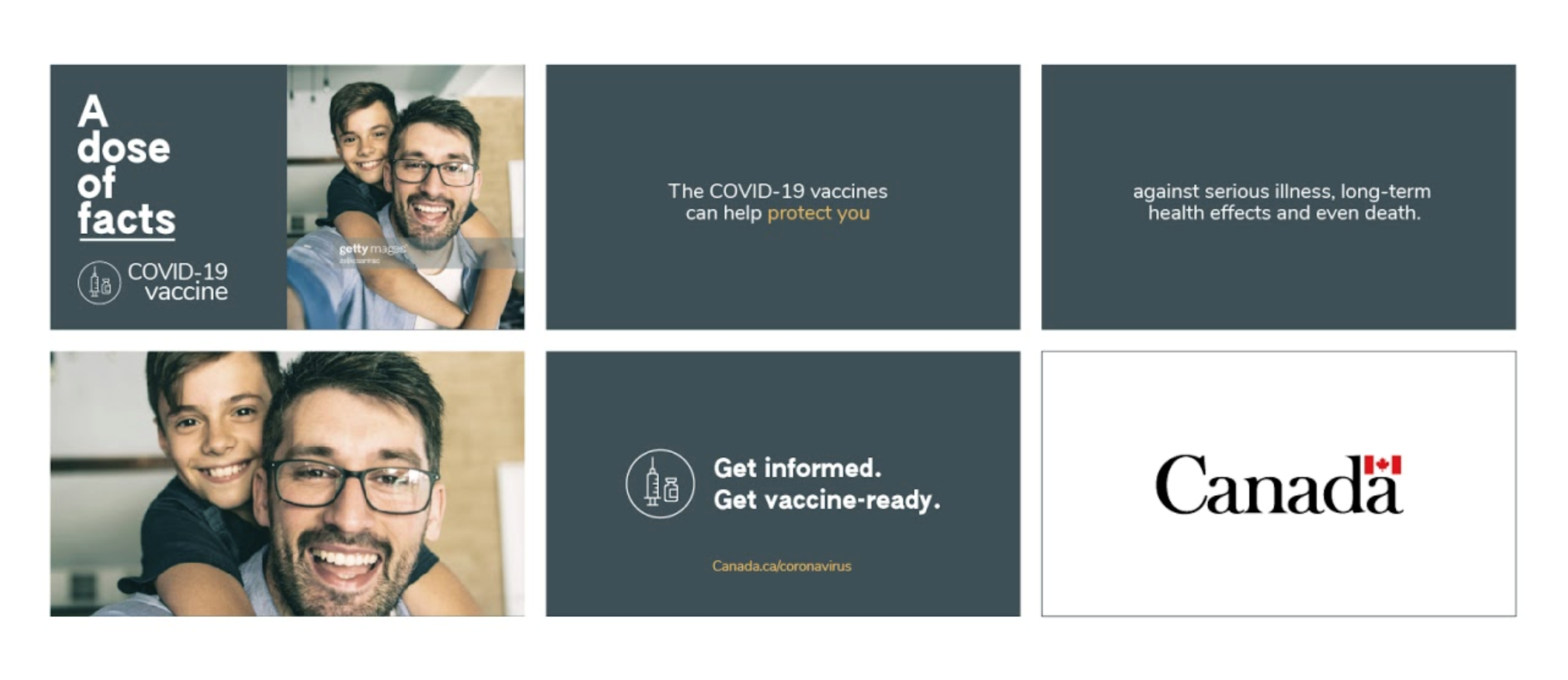
The above figure consists of six frames. The first frame is split vertically down the middle, on the left-hand side there is a dark grey background with large, white text reading ‘A dose of facts’ with the word ‘facts’ underlined. Below, in slightly smaller font, the text reads ‘COVID-19 vaccine’ with an icon of a circle containing a vaccine syringe and vial to the left of the text. On the right-hand side of the frame, there is an image of a man with a young boy on his back, both of whom are smiling. The second frame is, again, dark grey and white font reads ‘The COVID-19 vaccines can help protect you’ with ‘protect you’ being in yellow font. The third frame is the same dark grey with white text reading ‘against serious illness, long-term health effects and even death.’ The fourth frame is the same image of the father and young boy as was seen in the first frame. The fifth frame is back to the dark grey background that reads ‘Get informed. Get vaccine-ready.’ In white, bold font with an icon of a circle containing a vaccine syringe and vial to the left of the text. At the bottom of the frame, yellow text presents the URL ‘Canada.ca/coronavirus.’ The final frame ends on a white background with the Canada Wordmark in the middle.

The above figure consists of six frames. The first frame is split vertically down the middle, on the left-hand side there is a dark grey background with large, white text reading ‘A dose of facts’ with the word ‘facts’ underlined. Below, in slightly smaller font, the text reads ‘COVID-19 vaccine’ with an icon of a circle containing a vaccine syringe and vial to the left of the text. On the right-hand side of the frame, there is an image of a man and a younger man both reading a document. The second frame is, again, dark grey and white font reads ‘You can trust that the COVID-19 vaccines are safe’ with ‘safe’ being in yellow font. The third frame is the same dark grey with white text reading ‘because they meet the highest standards of safety, efficacy and quality’ with ‘highest standards’ in yellow font. The fourth frame is the same image of the man and a younger man both reading a document as was seen in the first frame. The fifth frame is back to the dark grey background that reads ‘Get informed. Get vaccine-ready.’ In white, bold font with an icon of a circle containing a vaccine syringe and vial to the left of the text. At the bottom of the frame, yellow text presents the URL ‘Canada.ca/coronavirus.’ The final frame ends on a white background with the Canada Wordmark in the middle.
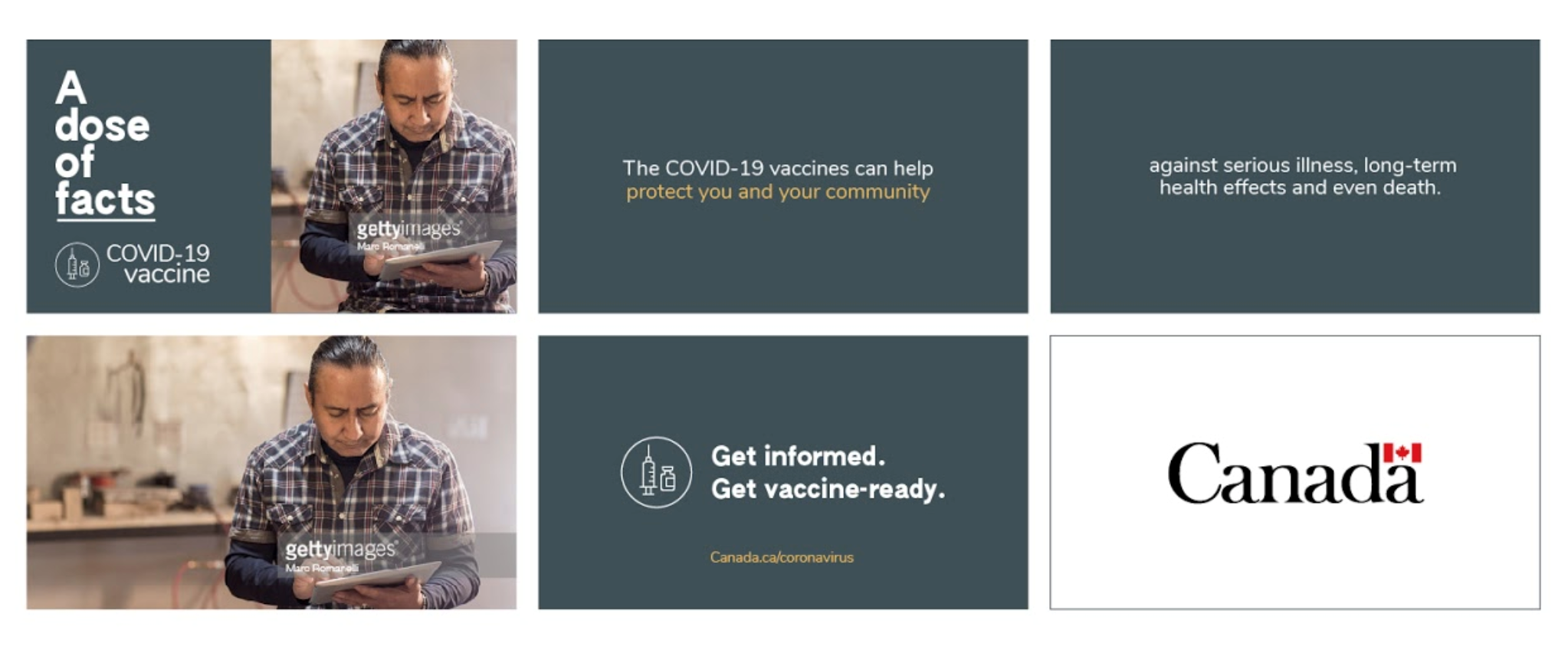
The above figure consists of six frames. The first frame is split vertically down the middle, on the left-hand spite there is a dark grey background with large, white text reading ‘A dose of facts’ with the word ‘facts’ underlined. Below, in slightly smaller font, the text reads ‘COVID-19 vaccine’ with an icon of a circle containing a vaccine syringe and vial to the left of the text. On the hand side of the frame, there is an image of a man in a plaid shirt who is drawing. The second frame is, again, dark grey and white font reads ‘The COVID-19 vaccines can help protect you and your community’ with ‘protect you and your community’ being in yellow font. The third frame is the same dark grey with white text reading ‘against serious illness, long-term health effects and even death.’ The fourth frame is the same image of the man in a plaid shirt who is drawing as was seen in the first frame. The fifth frame is back to the dark grey background that reads ‘Get informed. Get vaccine-ready.’ In white, bold font with an icon of a circle containing a vaccine syringe and vial to the left of the text. At the bottom of the frame, yellow text presents the URL ‘Canada.ca/coronavirus.’ The final frame ends on a white background with the Canada Wordmark in the middle.
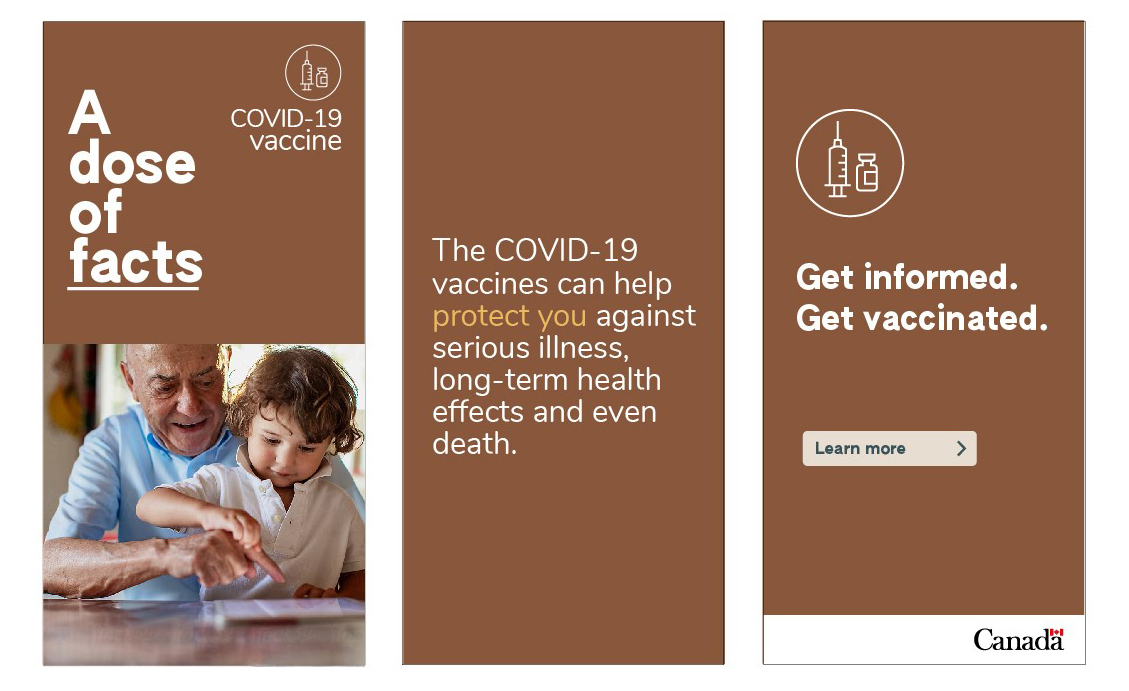
The above figure consists of three frames. The first frame is split horizontally across the middle, the top half has a brown background with large, white text reading ‘A dose of facts’ with the word ‘facts’ underlined. To the right, in slightly smaller font, the text reads ‘COVID-19 vaccine’ with an icon of a circle containing a vaccine syringe and vial above the text. On the bottom half of the image, there is an image of an elderly man with a child on his lap and they are looking down and pointing at a document. The second frame is, again, brown and white font reads ‘The COVID-19 vaccines can help protect you against serious illness, long-term health effects and even death’ with ‘protect you’ being in yellow font. The third frame is the same brown with white text reading ‘Get informed. Get vaccinated.’ with an icon of a circle containing a vaccine syringe and vial above the text. Below the text, there is a white, callout box that reads ‘Learn more’ with an arrow in green font. At the bottom of the frame, there is a white strip that has the Canada Wordmark on the bottom right.

The above figure consists of five frames. The first frame has a dark grey background with white text reading ‘Ask a COVID-19 vaccine expert’ with the words ‘vaccine expert’ in yellow font. The second frame depicts a young, smiling man against a light background, with the words ‘How do the COVID-19 vaccines work?’ to the right in dark green font. The third frame depicts Dr. Howard Njoo, Deputy Chief Public Health Officer (with his name and title overlaid in text on the bottom right of the frame) sitting at his desk. Below, the text reads ‘Dr. Howard Njoo (to camera) They word with your immune system so your body will be ready to fight the virus if you are exposed.’ The fourth frame depicts the same young man previously shown, although he is against a darker grey background now, and the text to the right reads ‘Make an informed decision about vaccination’ in white font. Below this text, smaller yellow test reads ‘Canada.ca/coronavirus.’ The final frame has a white background with the Canada Workmark in the middle.

The above figure consists of five frames. The first frame has a dark grey background with white text reading ‘Ask a COVID-19 vaccine expert’ with the words ‘vaccine expert’ in yellow font. The second frame depicts a young, smiling woman against a light background, with the words ‘How were the COVID-19 vaccines developed so quickly?’ to the right in dark green font. The third frame depicts Dr. Caroline Quach, Medical Lead, Infection Prevention and Control, CHU Ste-Justine (with her name and title overlaid in text on the bottom right of the frame) smiling towards the camera. Below, the text reads ‘Dr. Caroline Quach (to camera) The COVID-19 vaccines were developed quickly thanks to advances in science, international collaboration and increased funding.’ The fourth frame depicts the same young woman previously shown, although she is closer up and is against a darker grey background now, and the text to the right reads ‘Make an informed decision about vaccination’ in white font. Below this text, smaller yellow test reads ‘Canada.ca/coronavirus.’ The final frame has a white background with the Canada Workmark in the middle.
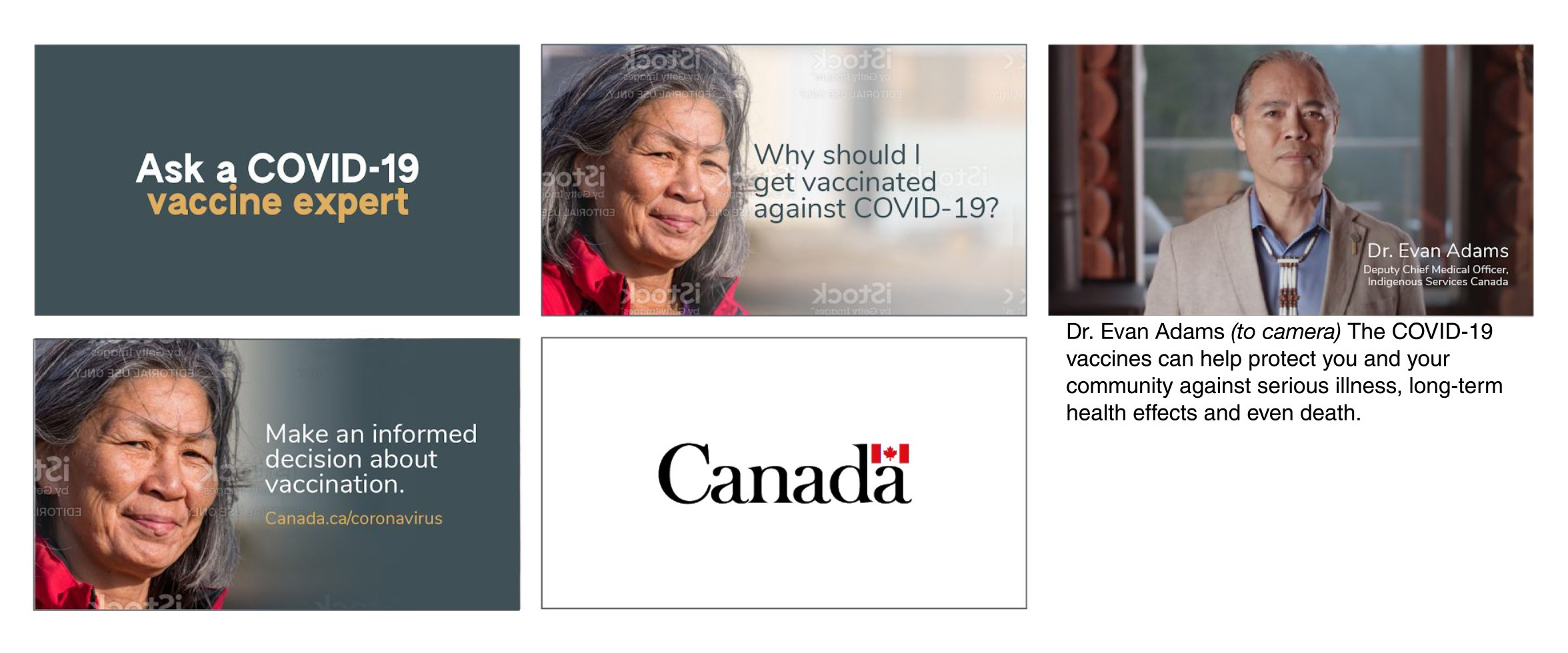
The above figure consists of five frames. The first frame has a dark grey background with white text reading ‘Ask a COVID-19 vaccine expert’ with the words ‘vaccine expert’ in yellow font. The second frame depicts an older woman against a light background, with the words ‘Why should I get vaccinated against COVID-19?’ to the right in dark green font. The third frame depicts Dr. Evan Adams, Deputy Chief Medical Officer, Indigenous Services Canada (with his name and title overlaid in text on the bottom right of the frame). Below, the text reads ‘Dr. Evan Adams (to camera) The COVID-19 vaccines can help protect you and your community against serious illness, long-term health effects and even death.’ The fourth frame depicts the same older woman previously shown, although she is against a darker grey background now, and the text to the right reads ‘Make an informed decision about vaccination’ in white font. Below this text, smaller yellow test reads ‘Canada.ca/coronavirus.’ The final frame has a white background with the Canada Workmark in the middle.

The above figure consists of three frames. The first frame has a dark grey background with white text reading ‘Ask a COVID-19 vaccine expert’ with the words ‘vaccine expert’ in yellow font. Directly below the text, there is an image of Dr. Caroline Quach, Medical Lead, Infection Prevention and Control, CHU Ste-Justine (with his name and title overlaid in text on the bottom right of the frame). The second frame had a white background with green text reading ‘How were the COVID-19 vaccines developed so quickly?’ The third frame had a dark grey background with yellow text reading ‘The COVID-19 vaccines were developed quickly thanks to advances in science, international collaboration and increased funding.’ Below, there is a white callout box with green text reading ‘learn more’ and an arrow. Below this box, there is the same image of Dr. Caroline Quach and her title of Medical Lead, Infection Prevention and Control, CHU Ste-Justine in white text. At the bottom of the frame, there is a white bar across the bottom that features the Government of Canada wordmark on the right.

The above figure consists of five frames. The first frame has a yellow background was six animated figures shown (in order from left to right, there is a woman with light skin and white hair, a woman with darker skin and black hair in a bun, a light skin male with short, blond hair, a male with darker skin and short, brown hair, a male with light skin, short brown hair and a blue face mask, and a woman with darker skin and dark brown curly hair), all wearing dark green shirts. There is also text in the middle of the frame. Smaller white font reads ‘the COVID-19 vaccine’ with a maple leaf to the right. Underneath, in larger white font reads ‘vaccines & you’ with the word ‘you’ in yellow font. The second frame has the same yellow background with white font on the left-hand side reading ‘Do COVID-19 vaccines have side effects?’ to the right-hand side, the light skin and short blond hair male animated figure is looking in the direction of the text. The next slide has a dark grey background with white text reading ‘Feeling some mild side effects is a normal sign that your body is building protection, and they should resolve within a few days.’ The next slide has a similar dark grey background, at the top, there is small yellow font reading ‘Find out more about’ with ‘The COVID-19 vaccines & you’ below. To the right of the word ‘COVID-19’ there is a maple leaf and the word ‘you’ is in yellow. At the bottom of the frame, there is white font reading ‘Canada.ca/coronavirus.’ The final frame has a white background with the Government of Canada Wordmark in the middle.
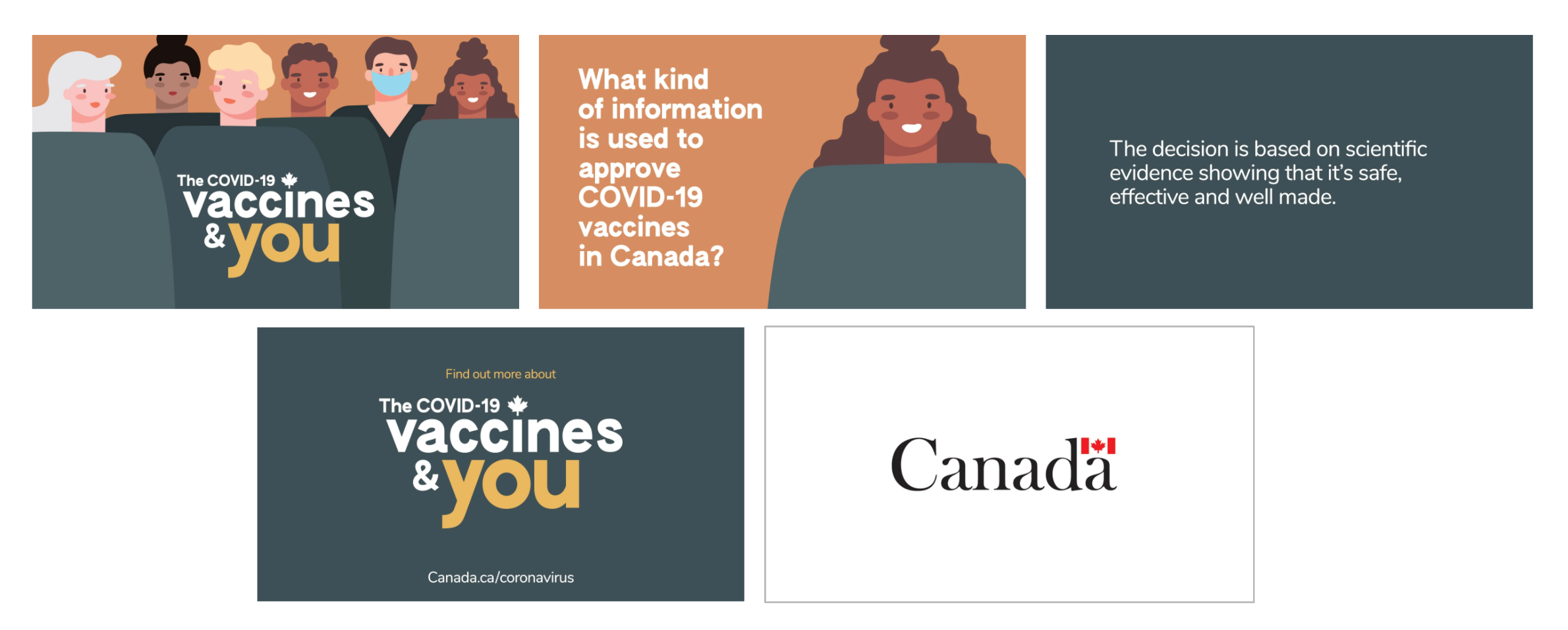
The above figure consists of five frames. The first frame has an orange background was six animated figures shown (in order from left to right, there is a woman with light skin and white hair, a woman with darker skin and black hair in a bun, a light skin male with short, blond hair, a male with darker skin and short, brown hair, a male with light skin, short brown hair and a blue face mask, and a woman with darker skin and dark brown curly hair), all wearing dark green shirts. There is also text in the middle of the frame. Smaller white font reads ‘the COVID-19 vaccine’ with a maple leaf to the right. Underneath, in larger white font reads ‘vaccines & you’ with the word ‘you’ in yellow font. The second frame has the same orange background with white font on the left-hand side reading ‘What kind of information is used to approve COVID-19 vaccines in Canada?’ to the right-hand side, the darker skinned female with brown curly hair animated figure is smiling and looking straight out. The next slide has a dark grey background with white text reading ‘The decision is based on scientific evidence show that it’s safe, effective and well made.’ The next slide has a similar dark grey background, at the top, there is small yellow font reading ‘Find out more about’ with ‘The COVID-19 vaccines & you’ below. To the right of the word ‘COVID-19’ there is a maple leaf and the word ‘you’ is in yellow. At the bottom of the frame, there is white font reading ‘Canada.ca/coronavirus.’ The final frame has a white background with the Government of Canada Wordmark in the middle.
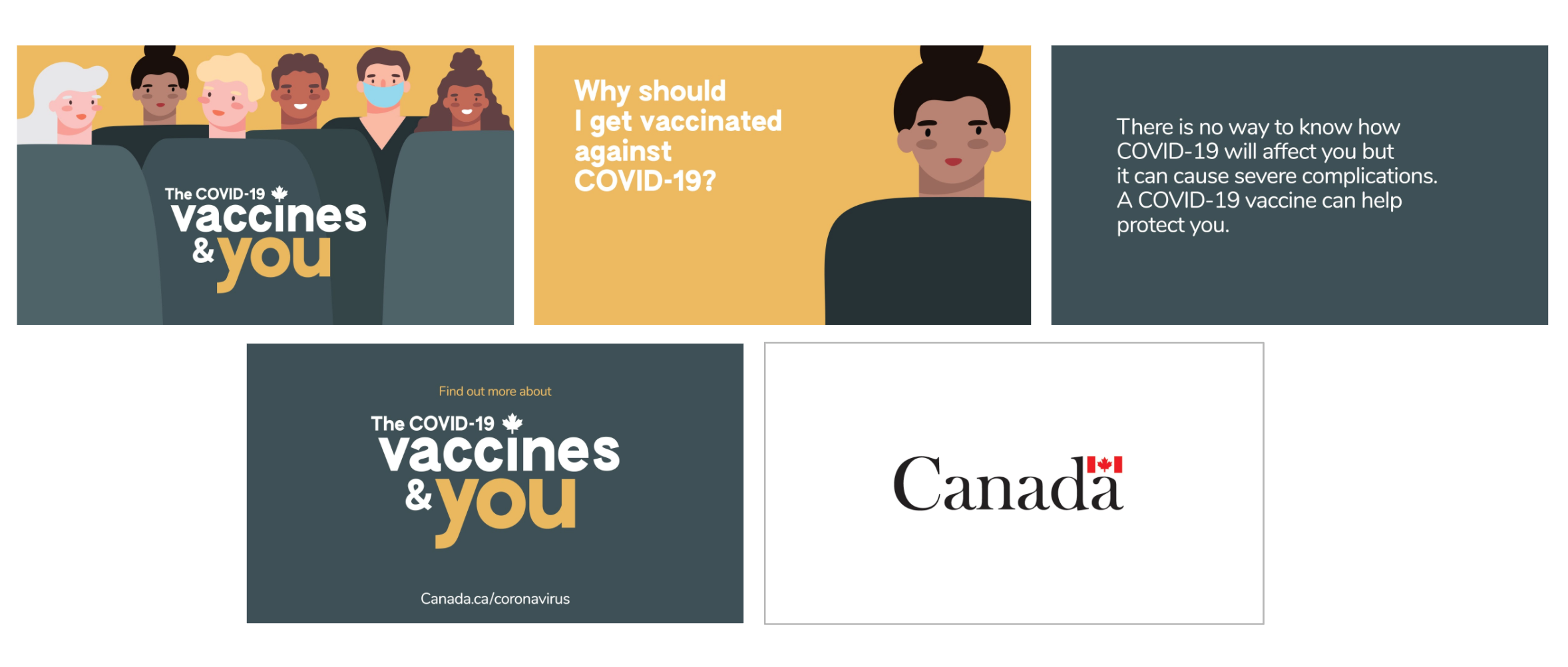
The above figure consists of five frames. The first frame has a yellow background was six animated figures shown (in order from left to right, there is a woman with light skin and white hair, a woman with darker skin and black hair in a bun, a light skin male with short, blond hair, a male with darker skin and short, brown hair, a male with light skin, short brown hair and a blue face mask, and a woman with darker skin and dark brown curly hair), all wearing dark green shirts. There is also text in the middle of the frame. Smaller white font reads ‘the COVID-19 vaccine’ with a maple leaf to the right. Underneath, in larger white font reads ‘vaccines & you’ with the word ‘you’ in yellow font. The second frame has the same yellow background with white font on the left-hand side reading ‘Why should I get vaccinated against COVID-19?’ to the right-hand side, the darker skin female with black hair in a bun animated figure is looking straight out. The next slide has a dark grey background with white text reading ‘There is no way to know how COVID-19 will affect you but it can cause severe complications. A COVID-19 vaccine can help protect you.’ The next slide has a similar dark grey background, at the top, there is small yellow font reading ‘Find out more about’ with ‘The COVID-19 vaccines & you’ below. To the right of the word ‘COVID-19’ there is a maple leaf and the word ‘you’ is in yellow. At the bottom of the frame, there is white font reading ‘Canada.ca/coronavirus.’ The final frame has a white background with the Government of Canada Wordmark in the middle.
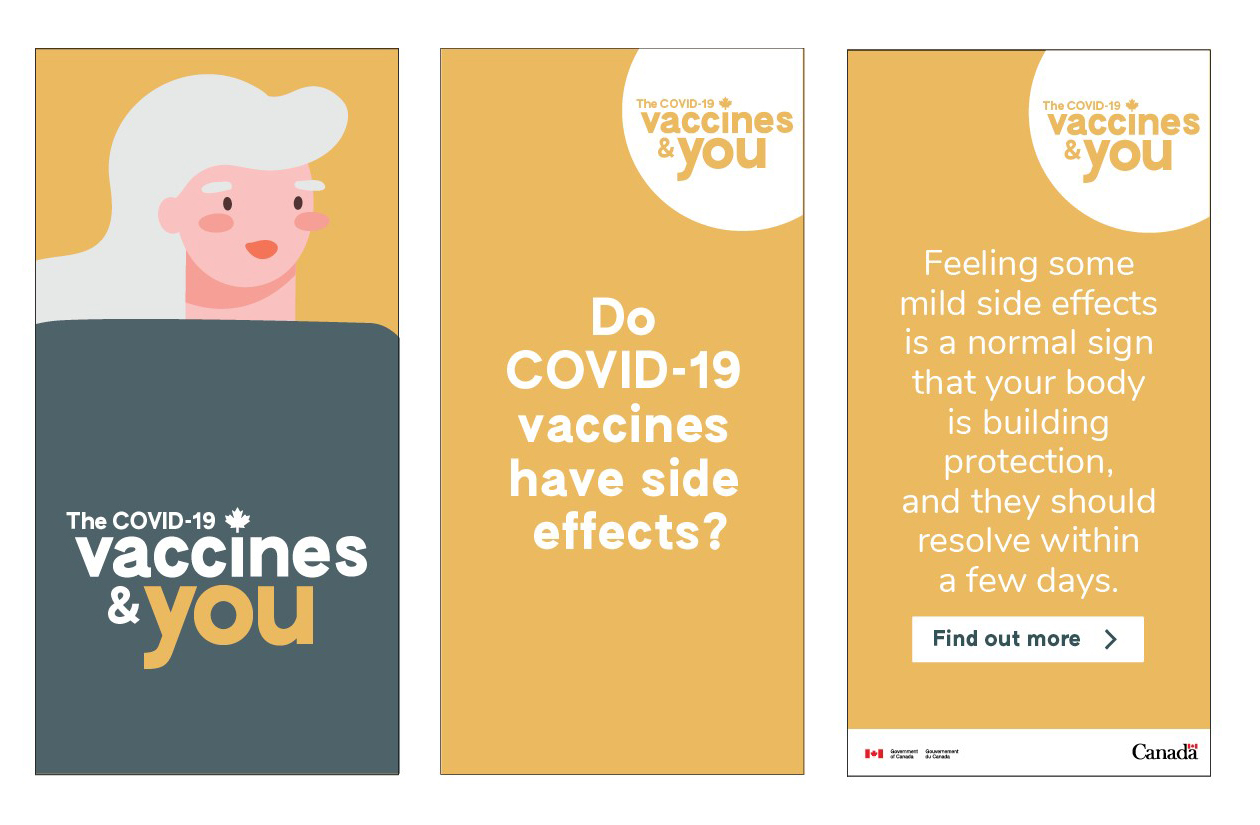
The above figure consists of three frames. The first frame has a yellow background with a female with light skin and white hair animated figure who is wearing a green shirt. Overlaid on the shirt there is smaller white font reads ‘the COVID-19 vaccine’ with a maple leaf to the right. Underneath, in larger white font reads ‘vaccines & you’ with the word ‘you’ in yellow font. The second frame has the same yellow background with white text in the middle of the frame reading ‘Do COVID-19 vaccines have side effects?’ In the top right of the frame, there is a white circle with yellow font, where smaller font reads ‘the COVID-19 vaccine’ with a maple leaf to the right. Underneath, in a larger font reads ‘vaccines & you.’ The third frame has the same yellow background with white text reading ’Feeling some mild side effects is a normal sign that your body is building protection, and they should resolve within a few days.’ Below, there is a white callout box with green font inside reading ‘learn more’ with an arrow. In the top right of the frame, there is a white circle with yellow font, where smaller font reads ‘the COVID-19 vaccine’ with a maple leaf to the right. Underneath, in a larger font reads ‘vaccines & you.’ At the bottom of the slide, there is a white bar across the bottom that features the Government of Canada wordmark on the right and a governmental department logo on the left.
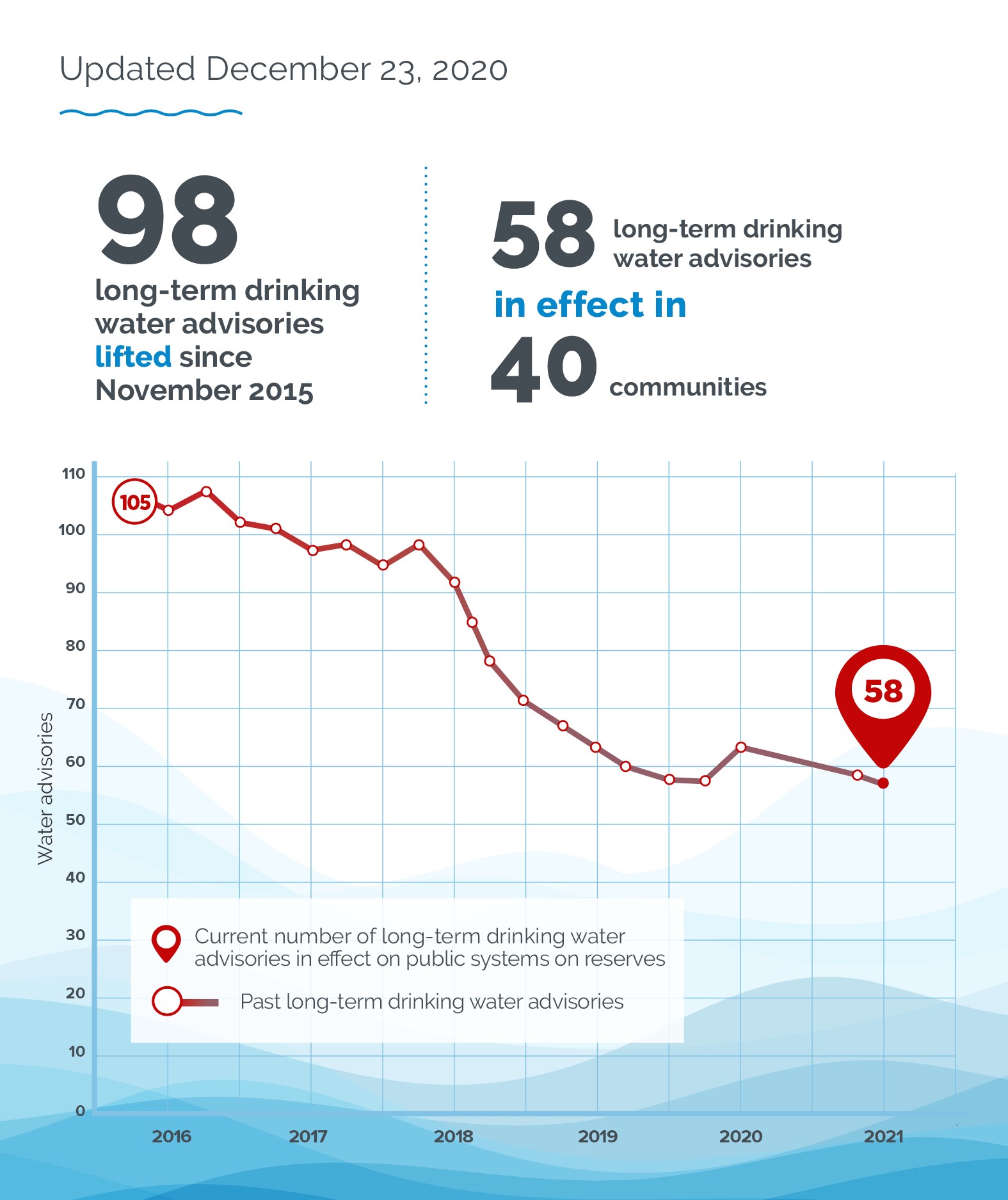
This infographic features a white background with a graphic of blue waves across the bottom third of the page. On the top left, the version date “Updated December 23, 2020” in written grey font underlined by a dark blue waved line. In the middle of the infographic to the left, text reads, “98 long-term drinking water advisories lifted since November 2015” in grey font, with the number “98” in much larger font than the other font, and the word “lifted’” in blue font. In the middle of the infographic to the right, text reads “58 long-term drinking water advisories in effect in 40 communities” where the numbers are in larger font, and the words “in effect in” is written in blue text. At the bottom of the infographic, there is a large chart, along the vertical axis there is water advisories (ranging from 0 to 110), and the horizontal axis is years (ranging from 2016 to 2021). In the graph, a red line tracks downwards, from left to right. The top left of the graph line is in the number 105 in a circle. The bottom right of the graph had the number 58 in a pinpoint icon. In the bottom left hand side of the graph, a legend depicts that the red pinpoint icon is “current number of long-term drinking water advisories in effect on public systems on reserves. Below, the legend depicts that each point on the graph line is “past long-term drinking water advisories.”